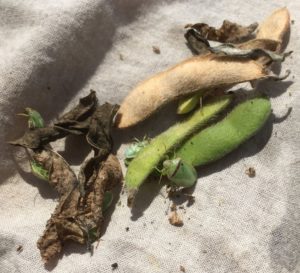While many fields are harvest ready, stink bugs are potential pests in the cotton and soybean fields that have yet to reach maturity.
Cotton should be scouted for stink bugs until 350 heat units, or approximately 15 days, after the field has cutout (<5 NAWF). Scout by opening 20-25 one-inch bolls and inspecting the bolls for evidence of internal feeding. Treat a field with more than 20% evidence of internal feeding.
Soybeans are susceptible to stink bug damage until the beans reach maturity. Some entomologists would say soybeans are safe when the beans reach R7 (one brown bean per plant). Others suggest the beans are still susceptible to economic damage until more of the beans on the plant are mature.
For most stink bugs in soybeans use an economic threshold of 36 stink bugs per 100 sweeps or 1 per ft of row. Red banded stink bugs have the ability to cause greater amounts of damage so use a lower threshold of 18 red banded stink bugs per 100 sweeps or 1 per 2 foot of row.
Scout soybeans with either a sweep net or a drop cloth. My preference is the sweep net. When using the drop cloth method, it is important to use a cloth and not beat the plants on the ground. This is because the smaller nymphs will be missed if you are not using a cloth to catch them.
Tuesday (July 17), I sprayed a soybean stink bug control trial in Victoria. The field has four different stink bugs including red banded, brown, green and southern green stink bugs. Today’s stink bug counts are in the figure below.
In this trial, acephate worked well as I found no stink bugs in the acephate treated plots. The pyrethroid insecticides tend to be a little weak on brown and red banded stink bugs, but the combination of Karate and imidacloprid did better than either product alone. Another product that may provide good control is bifinthrin. I hope to include it in later trials.
This trial was funded by the Texas Soybean Board. The product for this trial was provided by Syngenta, AMVAC and Sanders.
